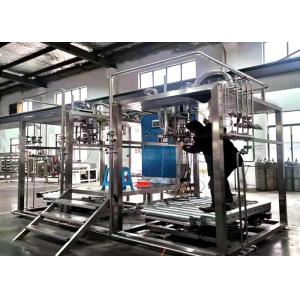4T/H 35-40℃ Filling Temperature SUS316 Jam Aseptic Filling Machine
Product Descripyion
Big bag aseptic filling machine for juice beverage packaging, storage and transportation: the large bag aseptic filling machine has its own aseptic room, and uses steam to perform three-point jet sterilization on the bag mouth, filling head and filling room to ensure the filling process. bacteria requirements. The packaging bag adopts aluminum-plastic composite aseptic bag, and the aseptic bag mouth sterilization, opening, filling and sealing are all completed in a sterile environment. Especially suitable for aseptic filling and filling of fruit juice, jam, concentrated puree, etc. Because the sterile bag can isolate oxygen and sunlight, the product can be stored at room temperature for more than one year, saving the cost and risk of low-temperature refrigerated transportation.
Specification
| Dimensions | 4800x2200x2600 mm (l*w*h) |
| Capacity | 2000-6000L/H |
| Filling Temperature: | 35-40oC |
| Power | 0.75kw |
| Air Pressure | 5bar |
| Applicable Bag Size | 5 to 220 liters aseptic bags |
| |
| PLC | Siemens 1200 |
| Touch Screen | Siemens |
| PID Temperature Controller | Fujifilm |
| Electric Elements | Schneider |
| Transducer | Fujifilm |
| Pneumatic Components | Airtac |
| Flow Meter | KROHNE |
| |

Process Flow

BIB Aseptic Filling Machine
The Bag-in-Box (BIB) Aseptic Filling Machine is designed for aseptically filling spout-prepared aseptic bags with sterile fluids like natural juice, concentrate, vegetable juice, fruit syrup, fruit jam, magma beverage, dairy product and pharmaceutical. The machine can use varous spigots including Vitop and Scholle's. It is designed with CIP (Clean-in-Place) function and a circuit for connecting to a CIP system.
 Double-head big bag aseptic filling machine
Double-head big bag aseptic filling machineThe capacity of the canned aseptic bag of the Big-bag aseptic filling machine is larger than that of the BIB aseptic bag. Both the large-bag aseptic filling and the BIB aseptic filling have multiple heads and double heads, and multiple single heads can be connected in series. Many people operate at the same time.
Advantages
As consumers have become more health conscious, the demand for food and beverage products without preservatives has increased. However, traditional methods combining sterilization with hot filling have not been suitable for products that are increasingly sold on their “fresh” and “natural” characteristics, due to the effect on product quality.
Consequently, cold aseptic filling has become a common technique with beverage manufacturers for products including UHT milk, fruit juices and sports/energy drinks. Its flexibility means that it is suitable for a wide range of products from fresh fruit dices and purees to marinades and dairy products. This diversity has also seen the development of a wide range of fillers and packaging types, from pouches and lidded trays to bulk bags and intermediate bulk containers (IBCs).



